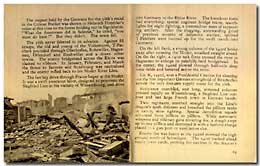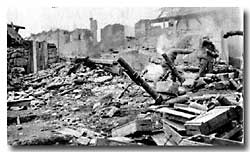

Pages 28 and 29
The respect held by the Germans for the 36th’s stand in the Colmar Pocket was shown in Heinrich Himmler’s order at this time to the forces holding out in Sigolsheim. “What the Americans did in Selestat,” he cried, “you must do here!” But they didn’t. The town fell.
The 36th never faltered in its advance. Against SS troops, the old and young of the Volkssturm, T-Patchers pounded through Oberhoffen, Rohrwiller, Hauenau, Offendorf and Bischwiller and a dozen other towns. The enemy bridgehead across the Rhine was slashed to ribbons. In January, February, and March the threat to Saverne and Strasbourg was neutralized and the enemy rolled back to his Moder River Line.
 The
last big drive through France began at the Moder. It was a swift knockout
blow, designed to penetrate the Siegfried Line in the vicinity of
Wissembourg, and drive into Germany to the Rhine River. The knockout force
had everything: special engineer bridge trains, searchlights for night
fighting, a tremendous mass of supporting artillery. After the slugging,
unrewarding grind of previous months of defensive warfare, spirited of T-Patchers
were buoyed up for the swift march into Germany.
The
last big drive through France began at the Moder. It was a swift knockout
blow, designed to penetrate the Siegfried Line in the vicinity of
Wissembourg, and drive into Germany to the Rhine River. The knockout force
had everything: special engineer bridge trains, searchlights for night
fighting, a tremendous mass of supporting artillery. After the slugging,
unrewarding grind of previous months of defensive warfare, spirited of T-Patchers
were buoyed up for the swift march into Germany.
On the left flank, a strong column of the 143rd broke away after crossing the Moder, smashed straight ahead. On the far right, a 141st task force crossed the river in Haguenau to enlarge its painfully-held bridgehead. In the center, the 142nd plowed through half-mile deep mine fields and battered across the river.
Co. K, 143rd, won a Presidential Citation for cleaning out the first important German stronghold of Bitschoffen astride the only first-rate supply route for the 36th.
Resistance crumbled, and long, armored columns pressed rapidly on Wissembourg, a Siegfried Line outpost and last large French town in German hands.
Two regiments marched straight into the Line’s dragon’s teeth defenses and breached the pillbox ranks in canny, slow fighting. Special demolition sqauds advanced from pillbox to pillbox. While automatic weapons and riflemen gave covering fire, a dough crept up to one pillbox and destroyed it with a beehive charge placed in a gun port or ventilation slot.
Enemy fire was heavy as the 142nd stormed the high ground north of Schweigen. The 141st pushed ahead nearly 1000 yards, probing for cavities in the dragon’s
Copyright © 2000
All Rights Reserved
This World War II history
is sponsored and maintained
by TMFM